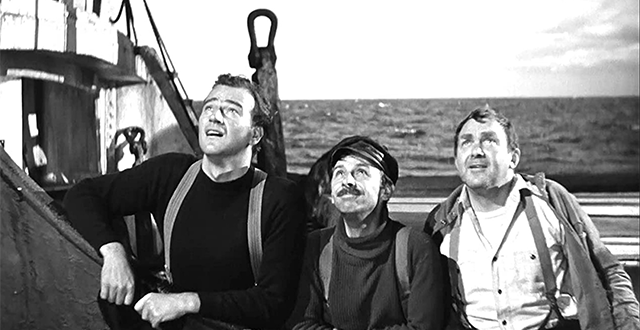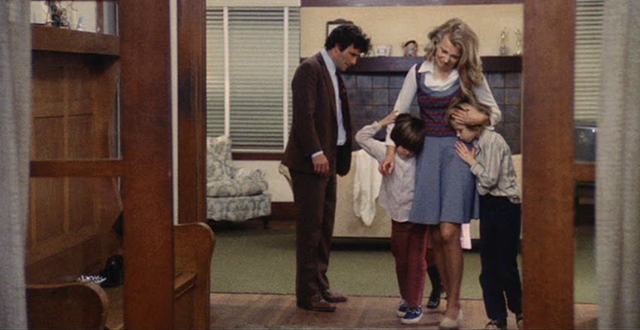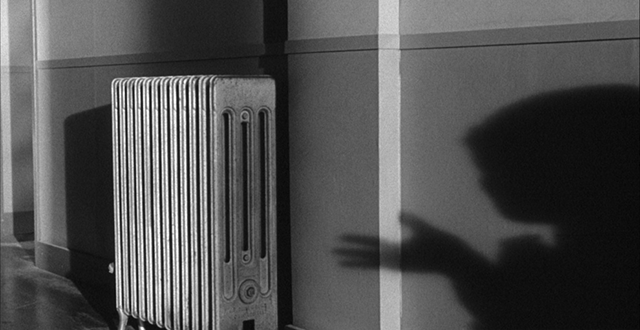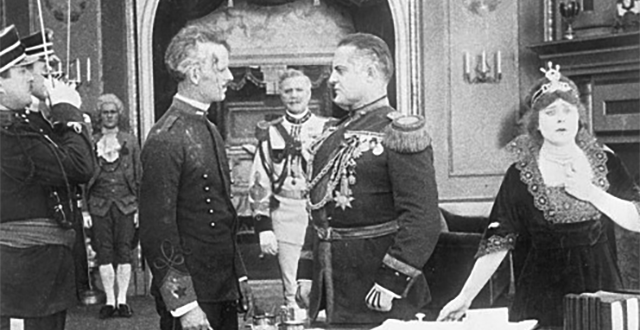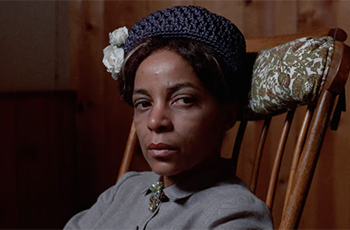News
Out of the Vaults: “The Long Voyage Home”, 1940
Meher Tatna
The instrumental strains of “Harbor Lights,” the popular song from 1937, sound over the opening prologue: “With their hates and desires men are changing the face of the earth – but they cannot change the sea. Men who live on the sea never change – for they live in a lonely world apart as they drift from one rusty tramp steamer to the next, forging the life-lines of Nations.”
The camera moves back across an iridescent sea with a hulking ship in the background to the shore where native women undulate to a haunting melody. The scene then shifts to the Glencairn where rough-hewn men with weather-beaten faces listen to the music.
So, begins John Ford’s The Long Voyage Home, starring John Wayne. But neither men are the real star of the picture. That star is cinematographer Gregg Toland. It’s rare that a director shares credit on the same card with his cinematographer. Ford does it here, as did Orson Welles on Citizen Kane a year later, again with Toland.
This black and white film is a masterpiece of visual expressionism, with Toland experimenting with various lenses to achieve deep focus, using high contrast lighting and hardly moving the camera so every action is captured within its frame. We see the decrepit ship become a thing of beauty with the moonlight on its rails and splashed across its deck, the fury of a storm battering shimmering water against the window of the bridge, the cobblestones of a backwater city gleaming through the legs of the sailors passing, the light and shadows falling on the faces of the sailors as they huddle in their cramped quarters below decks, the camera locked on the foot of a sailor as he falls backward to his death.
Wayne told his biographer Maurice Zolotow: “Usually it would be Mr. Ford who helped the cinematographer get his compositions for maximum effect ... but in this case, it was Gregg Toland who helped Mr. Ford. The Long Voyage Home is about as beautifully photographed a movie as there ever has been.”
Based on four one-act plays by Eugene O’Neill, the screenplay was written by Dudley Nichols, a friend of O’Neill’s. O’Neill was a seaman himself in his early days, and his own experiences informed his plays. He said that this was one of his favorite films and that he wore out the print presented to him by Ford from multiple viewings.
The action in the story was moved from WWI to the beginning of WWII. The Glencairn is bound for England from the Caribbean and stops in Baltimore to pick up ammunition, then has to pass through a no-man’s land in the Atlantic patrolled by Nazi ships and aircraft on its way to Southampton. The loneliness of these lifelong sailors is shown in their lives aboard, discounted by their captain, unable to protest the dangerous cargo or the hazardous route through the Atlantic, cramped into meager quarters, sustained only by the friendships among them, doomed to repeat the voyages over and over as none has a family to go back to, save one.
That one is the Wayne character, a young Swede named Ole, a very different role from the cowboys he was used to playing, but later considered it one of his best performances. He had to be persuaded to take the part by Ford as he was worried about the Swedish accent. Thomas Mitchell (Scarlett’s father in Gone With the Wind), is really the leader of the ensemble, the old Irish salt Driscoll, who keeps the band together through the drinking and brawling. Other standouts include Ian Hunter as Smitty, the Englishman who is accused of being a German spy in a heartrending scene, and Ward Bond as Yank, who exemplifies the struggle to live that these men are up against every day. Mildred Natwick has a fine turn as a prostitute.
The film was not a big success on its opening, due perhaps to its downbeat story and lack of a love interest. Its poster is actually quite misleading, featuring the seamen hoisting up several brightly dressed island girls onto the boat under the caption “The Love of Women in Their Eyes ... THE SALT OF THE SEA IN THEIR BLOOD!” It actually lost $225,0000 in its initial run. But it received excellent notices and earned several Oscar nominations – Best Black and White Cinematography, Best Film Editing, Best Original Score, Best Special Photographic Effects, Best Sound, Best Screenplay, and Outstanding Production (Best Picture). (Ford won for Best Director for Grapes of Wrath that same year; Toland was his cinematographer on that as well.) The National Board of Review named it one of the ‘ten best’ of 1940.
As a publicity stunt, producer Walter Wanger paid $50,000 to nine well-known artists of the time to paint scenes from the movie and the actors in character. The paintings were featured in ‘Life’ magazine and displayed in museums across the country as a traveling exhibit.
The Long Voyage Home was restored by the UCLA Film & Television Archive with funding provided by the Hollywood Foreign Press Association and The Film Foundation. The Archive holds excellent safety preservation picture and sound master positives made from the original elements; however, there are no 35mm prints of the film currently available. The sound was re-recorded from the variable area and variable density track positives to WAV files, and was sequenced and synchronized. Once the digital restoration of the soundtrack was completed, a new optical soundtrack negative was created along with a mag track for preservation. A new polyester 35mm duplicate negative was created from the fine grain master positive and that, along with the restored track negative, will be used to create new 35mm prints for archival screenings.
An excellent Criterion print is available on HBO Max.
COMMEMORATING 30 YEARS OF TFF
As people around the country are about to celebrate Thanksgiving away from their loved ones, I suppose that many of us are contemplating the meaning of the holiday in the abstract, formed from memories of Thanksgivings past. The cultural trappings are one thing, but the understanding of what sets this day apart from Christmas or Passover or Eid is something entirely different. I suppose that Thanksgiving is notable for being an entirely secular national holiday that is observed as reverently as a religious holiday. When I was young, it embodied a spirit of generosity. I wonder if that’s still the case. What it has come to mean is family with a capital F, with all its contradictions and heartbreaks and glories.
There are a couple of movies that The Film Foundation has helped to restore that bring the spirits of past and present to mind. When I was young, Alfred Hitchcock’s Saboteur, restored by the Library of Congress, was written off as a lesser film by many people, including Hitchcock himself. It was a dry run for North by Northwest, it had too many ideas in it, the lead and the villain were miscast, and so on. At this point I’ve seen the film many times, and it seems to grow with each viewing. Robert Cummings’ defense plant worker, wrongfully accused of committing sabotage and killing his best friend, goes on a cross-country journey much like Cary Grant’s in NBNW, but along the way he is met by good Samaritans who discard all doubt as they recognize the goodness he emanates—a long haul trucker, the members of a circus troupe and, most movingly and magically, a blind man who lives alone in the wilderness played by a wonderful old theatre actor named Vaughan Glaser.
In the matter of family, I’m thinking of John Cassavetes’ A Woman Under the Influence, restored by UCLA, in which family is the bedrock and the stumbling block, the crucible and the sustaining power. It’s family that drives Gena Rowlands’ Myrtle to madness, and it’s family that grounds her and lights her from within. The miracle of Cassavetes’ film is that it embodies these opposing forces and states all at once. Myrtle waiting anxiously for her kids to come home from school…Peter Falk as her helpless touching husband trying to decree that everything be normal again, Falk’s mother (played by Cassavetes’ own mother) casting a cold eye on her daughter-in-law one minute and later urging her son to go easy on her, the entire extended family rendered speechless as they watch Myrtle fly off into the stratosphere once again…it’s all the chaos and swirling and criss-crossing impulses and emotions of family in one movie, joyous and unkempt and terrifying, and you just want to dive right into it because that’s where life begins.
Happy Thanksgiving…and happy belated 106th birthday to Norman Lloyd.
- Kent Jones
Follow us on Instagram, and Twitter!
SABOTEUR (1942, d. Alfred Hitchcock)
Preserved by the Library of Congress with funding provided by the Hollywood Foreign Press Foundation and The Film Foundation.
A WOMAN UNDER THE INFLUENCE (1974, d. John Cassavetes)
Restored by UCLA Film & Television Archive. Restoration funding provided by Gucci and The Film Foundation.
COMMEMORATING 30 YEARS OF TFF
In 1923, William Carlos Williams wrote an untitled poem that he included in his remarkable Spring and All. When his first volume of collected poems was published 15 years later, he had given what is now his best-known poem a title. “To Elsie” is named after Elsie Borden, a disabled woman who grew up in an orphanage and who worked for the Williams family in New Jersey. The poem famously begins: “The pure products of America / go crazy…” And it ends, less famously but so hauntingly: “No one / to witness / and adjust, no one to drive the car.” Dr. Williams’ great work was a beacon for the young Allen Ginsberg when he wrote his longer clarion call “Howl” in 1955: “I saw the best minds of my generation destroyed by madness, starving hysterical / naked…” And, a few lines from the end, “O starry-spangled / shock of mercy the eternal war is here…” Ginsberg was read closely and later befriended by Bob Dylan, who sounded the call in a rougher and rowdier register in “A Hard Rain’s Gonna Fall” and, later, in a more plangent tone in “All Along the Watchtower.” And roughly concurrent with Dylan, from another side of America, came Sam Fuller’s bargain-budget Shock Corridor, restored by UCLA with the help of The Film Foundation and the Hollywood Foreign Press Association. In Fuller’s independently made tabloid vision of America-as-madhouse, the pure products have all gone crazy, as Robert Polito observes in his Criterion essay on the film. The best minds have all been destroyed by madness, the hard rain is already falling and there is no way out of here. A reporter pretends to be a madman in order to gain admittance to an insane asylum to investigate a murder. In the asylum, he encounters a nuclear physicist who thinks he’s a little boy, a traitorous Korean War vet who thinks he’s a Confederate General, and a black man who has integrated a Southern university who thinks he’s the founder of the KKK. In the end, the reporter himself actually does go mad…and wins the Pulitzer Prize. Shock Corridor was not greeted warmly when it was released in September 1963. Two months later, the President was assassinated, and the endless high-profile convulsions of the decade began.
But when did the convulsions begin? And did they ever really end?
- Kent Jones
Follow us on Instagram, and Twitter!
SHOCK CORRIDOR (1963, d. Samuel Fuller)
Restored by UCLA Film & Television Archive with funding provided by The Film Foundation and the Hollywood Foreign Press Association.
Out of the Vaults: “Civilization”, 1916
Meher Tatna
On October 21, 1916, the La Crosse Tribune carried a full-page advertisement for the next day’s release of Thomas Ince’s epic silent movie Civilization. Under a black and white picture of a listing ship going down in a storm as a lifeboat full of people foundered nearby, the breathless headline proclaimed:
Thos. H. Ince’s $1,000,000.00 SPECTACLE
Vividly Pictures the Modern Menace of SUBMARINE WARFARE
A Masterpiece that throws a glaring light on the world’s flaunting boast of a higher progress.
Below that are the following details:
Actual Sinking of an Ocean Liner.Two Battleships Sunk by United States Navy.$18,000 Used for Ammunition in One Battle.40,000 People Employed.10,000 Horses in Thrilling Cavalry Charges.40 Aeroplanes in Great Air Battle.Every Death-dealing Device Known to Modern War in Operation.One Year in the Making.Cost $1,000,000.00.Entire Cities Built and Destroyed.An Awe-inspiring Spectacle that one minute makes your blood run cold and another thrills you with its touches of human gentleness.The Story of the Greatest Love of the Ages – the Love of Humanity.
Promising a “Prologue by Flesh and Blood Actors,” the shows were priced at 50¢, 75¢ and $1; 25¢ for bargain matinees.
The film actually only cost $100,000 according to film archivist Brian Taves in his book Thomas Ince: Hollywood's Independent Pioneer, and earned $800,000 at the box office. It opened in Los Angeles in April 1916, then was recut with additional scenes for its New York premiere later that year.
Ince, the producer of about 800 films, who was the first to build his own studio, Inceville, with an assembly line system of filmmaking, is best known nowadays as the man who met a mysterious death at age 44 aboard the Oneida, William Randolph Hearst’s yacht, on which Ince was a guest. Rumors circulated about how he was shot in the head by Hearst, though officially he was reported to have died of a heart attack. Gossip columnist Louella Parsons who had been on the yacht was supposedly paid off by Hearst with a lifetime contract to syndicate her column in his newspapers in exchange for her silence.
Ince was also a director on Civilization, along with Reginald Barker and Raymond B. West, a film which is considered one of the first anti-war films. In 1916, the US had not yet joined WWI. The Democratic National Committee claimed that this was the film that helped Woodrow Wilson regain the presidency in 1916; his slogan “He Kept Us Out of War,” inspired Ince to make the film. Wilson was shown the film before its release and a print was even sent to the Pope. Nevertheless, the US did eventually join the war in 1917, whereupon the film was yanked out of theaters.
Originally titled He Who Returned, the film is a Christian allegory written by C. Gardner Sullivan and was the first one in which an actor (George Fisher) portrays Christ, billed as “the Christus” in the opening credits. The film is set in a peaceful European country whose king Wredpryd (Herschell Mayall in full army regalia) decides to start a war to increase his power. The male populace is conscripted by force, the women start a movement called Mothers of Men, and one of the king’s courtiers, Count Ferdinand (Howard Hickman) is ordered to combat because he invented a submarine that could torpedo enemy ships. But when faced with sinking a ship carrying not only ammunition but innocent passengers, he refuses and sinks his own ship instead. His change of heart is because of the influence of the pacifist fiancée (Enid Markey) he left behind.
Gravely injured, Ferdinand is rescued but descends into some sort of purgatory where the spirit of Christ inhabits him. Once back in Wredpryd, the king – “a modern Pontius Pilate” according to the supertitle – orders his execution, but Christ emerges from the Count’s body and takes the king to the battlefields to show him the havoc he has wreaked. The king repents and peace returns to the land.
The battle scenes are quite spectacular, with three cameramen credited. Considering that cameras were immovable back then, what Ince has achieved is impressive, wrangling the ships and seas as well as the hundreds of extras in the land battle scenes. Like most silent movies, the acting is declamatory and overly theatrical, and the supertitles veer into the banal. Variety’s reviewer was moved to say, “In his effort to project pathos, he slops over into bathos.” The religious messages are unrelenting as well, but given the time and circumstances of the film’s release, it was a great success and received very good notices, some reviewers comparing it favorably to D.W. Griffith’s Birth of a Nation. It was re-released several times, the last time in 1931.
However, the Los Angeles Times reviewer ignored the pacifist message, dismissed the poster’s breathless dedication to “that vast army whose tears have girdled the universe – the Mothers of the Dead,” and wrote that the depiction of Christ was “…not daring, it is only poor taste.” He went on to damn the film further: “Realizing the vast sum of money and the huge investment of talent and good faith that have been expended in this pretentious film, it is with deep regret that I am compelled to report it as a disappointment.” He was unmoved by the interview that Fisher, the actor playing Christ, had given to his paper, explaining that he lived the life of a recluse, spending his time in study and meditation in preparation for the role. “I can say in truth that the playing of this part has affected my whole life and the impressions will never leave me,” he told the Times.
Civilization was restored by The Museum of Modern Art with funding provided by the Hollywood Foreign Press Association and The Film Foundation. The source material was a shortened version that was used as the basis from a 1931 re-issue; it was all that survived of the film.
